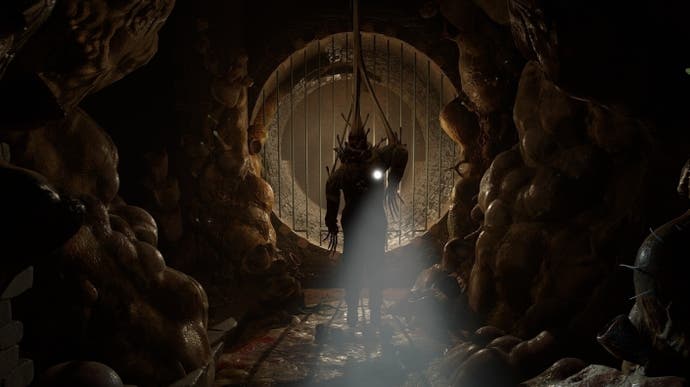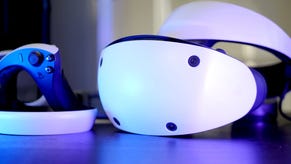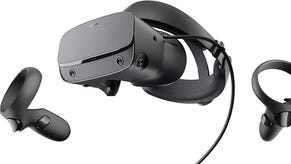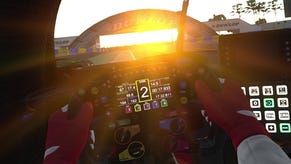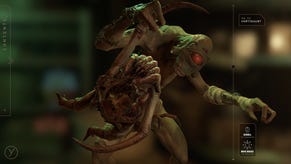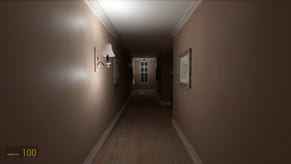Half-Life: Alyx review - a legend returns in elegant form
Another fine Mesa.
The Strider is the greatest of all Half-Life's creations, if you ask me. Sure, you could argue that it's just another spin on HG Wells' tripods, but seriously, look at the thing! Those legs, so horribly long and horribly jointed, that hideous hint of poultry flesh and machinery spliced together, all pain and wrongness. In Half-Life 2, I watched one of this awful lot stoop to duck under a bridge, and the thing about the Strider is that it never reminds you of just one thing, always a horrible bodging-together - almost a flamingo as its joints worked, yet almost grandparent nipping up into the attic for something heavy too. An internal life: that sense of self-preservation and cruel intelligence they have, of seeing only their own priorities. That sense of being autonomous in the moment, but also deeply mission-driven. They give me goose-bumps because it's so entirely clear that they can probably get goose-bumps themselves.
I had been waiting for this moment, then. Half-Life: Alyx, set five years before the events of Half-Life 2 and delivered sixteen years - is that possible? - since Half-Life 2 and thirteen years since Episode Two, the last installment. (How we had talked at the time about that gap between the first two Episodes. We had no idea.) Suddenly, City 17 lies before me once more. I am on a rooftop somewhere: Alyx Vance, 19-year-old daughter of Eli Vance, on reconnaissance for the resistance.
The metropolis is a mess of alien cables, black and heavy, draped thoughtlessly and sagging over honey-coloured European architecture with its weary finials and tiles and crenelations. It's VR, so a moment or two to look at the creamy skybox dithering into distant mist, then another moment to delight in a nearby radio, fiercely analogue tech, that can be picked up and heaved around, the dials turning and moving a little marker along the display, an aerial that properly extends and everything.
Behind me, inside a little conservatory, there is a video call from Dad, and more importantly there's a range of felt pens that have been used on the dirty glass to map Combine movements, but which can also be used to - what? - do anything really. Graffiti, Killroys, my daughter's name in my own instantly recognisable handwriting, somehow captured inside a video game space. I'm on the move, so I heave back a hidden door and explore a few dingy Winston Smith bedsit rooms. Then out again onto a different ledge and, do tell me, what in the world is that sound?
That sound is a strider, horribly large and horribly close, heaving its carcass body up the side of a building, stepping where it wants because the crumbling world of human things is not really a concern for an alien invader. It stops. Has it seen me? I stare up - because it's VR, I'm actually staring up - at this awful, wretched thing that I have always loved, and which is now here more fully than ever before, its knotty joints bolstered with servo-motors and shards of the Combine's black-slate tech. It hasn't seen me. It doesn't care. It turns and unplugs a clump of cables from a nearby building - the human world is its junction box - and then it's off into the distance. And yes! I had been waiting for this moment. And this moment did not let me down.
Not my only encounter with a strider in Half-Life: Alyx, but I'll honestly try to spoil little more than that. What I should say is that for the last few days I have been a bit of a strider myself, strangely focused on a private agenda, strangely blind to the finer details of the human landscape around me, as I have navigated City 17 with a VR headset covering my eyes - two worlds, one laid over the other. All this, as I've taken on headcrabs and Combine troopers and all the rest, all this as I have puzzled and rewired and upgraded - while simultaneously bodging around my own PC set up by my desk. House cats and scarves dumped on the backs of chairs startled me when I brushed against them at the wrong moments - generally moments involving headcrabs. My daughter, moving a doll's house behind me one afternoon, almost finished me off in a boss fight when we bumped together. "When you're behind me, tell me you're behind me!" I said. Five minutes later, when I was deep in the horror of the underground somewhere, she obliged, having snuck up close before announcing, "I'M BEHIND YOU, DADDY."
In other words, Half-Life was always going to work in VR. But what's fascinating is how it works. If you're expecting an explosion of let's-try-anthing creativity a la Boneworks, a game in which every conceivable kind of physics interaction is gleefully gimmicked together as you tumble through its wonderfully scrappy campaign, you're going to be a bit disappointed. Half-Life would rather focus its ambitions - and in turn rein-in the scope of what you can do - than risk breaking the illusion or frustrating the player. Something is lost in that decision, certainly. It's Alyx's way or the highway. But a lot is gained too.
As a result, Alyx is marked by restraint. Which is to say, I think, that it understands that VR itself is still such a continuous gimmick for many people that it can play things straight, paring the Half-Life concept back closer than ever before. Yes, it has radios to play with and the inevitable VR piano to prod out a Goldberg Variation on, but it's not one of those VR games that serves as the equivalent of those early 3D movies where people were forever throwing knives at the screen. Most of the time, it uses VR to steadily put you deeper and deeper into the fabric of this grimy, flaking Victory Gin world.
This is a simple story, direct yet consequential, studded with wonderful set-pieces, most of which are pitched towards a sort of sci-fi-tinged survival horror: you, a gun, ammo scavenging and them lurking all around as you slowly inch towards your next destination. VR is used to continue the Half-Life ambition, begun with that tram-ride back at Black Mesa and extended via the Gravity Gun and the magnifying glasses and the facial animation tech of Half-Life 2 to truly embed players in its reality. Cats, children, scarves and bookcases aren't just victims of this approach. They feel like an important part of it.
The basics are straightforward. All I'm going to tell you of the plot is that you're trying to meet up with your dad and figure out what big strange thing the Combine's currently so excited about. Events zip along quite briskly and objectives are always clear. If there's a problem, it's that the game is hemmed in a little, in terms of narrative, because it so clearly has one specific job to do.
The controls are as clear-headed as the narrative. Playing room-scale or simply standing with a more confined space, you can choose one of four movement options, two of which work brilliantly as teleport jobs while the other two offer continuous movement guided by either the hand or the head and seemed to me pretty clumsy and nausea-inducing. Whatever movement you choose, one hand generally holds a weapon or gadget - switching them is as easy as pressing a button and waving your arm up and down - while the other is always free for interacting with the environment, opening doors, grabbing ammo clips from your backpack and ramming them home, priming grenades before lobbing them.
Both hands wear gravity-gloves, a cobbled-together precursor of the gravity gun. They're beautiful things. Hold your hands up and it's like some addled genius has built mittens for your out of diodes and Technical Lego, while little displays show you your health and ammo levels. These things are not for pulling sawblades out of walls and firing them into crowds of zombies, though. They're precision affairs, a little flick of the wrist yanking a highlighted object out of the environment and bringing it into your hand with a neat little slap.
The gloves have been created by a new character, Russell, played by Rhys Darby, who despite being cast as a genius, stays wonderfully close to Murray, the dim and easily bruised band manager from Flight of the Conchords. Because Alyx also speaks - a performance from Ozioma Akhaga that is forever revealing different facets of personality, while being wonderfully alive to graveyard wit - the game is essentially a two-hander, Alyx out in the world while Russell monitors her progress from a distance, cowardly, prideful, tender and quirky by turns. I love this combination. Beyond anything else, following up the biggest video game in the world with a Rhys Darby simulator is a total power move.
The texture of the game these two travel through is relentlessly - and gloriously - practical, pragmatic and down-to-earth. This is a game about navigating space and killing everything you meet, but it's all so carefully wrought. A nervous skittering on the soundtrack is ultimately the buzzing of an old fluorescent light tube. Puzzles are made of gravity, stacked boxes, and wood used to prop open windows. These challenges can be maddeningly clever, but Newton always keeps them honest at the same time. Elsewhere, a vaguely celestial sounding clue in the main plot turns out to have a very mundane solution, while car posters you pass on the remains of the subway show boxy Soviet saloons accompanied by ad-talk that's even more oppressive than usual: Reality Defined. This is science-fiction with both feet on the ground.
This works because the interaction, enlivened by VR, is tangible and playful. It elevates everything, from wiring puzzles - a real theme of this game, using both a gadget that allows you to see electricity flowing through gates inside the walls, and a bit of good-old-fashioned cable-following - to hunting for ammo and other supplies, including the worm-eaten hockey pucks of grey stuff you use as currency in the machines that allow you to upgrade your weapons.
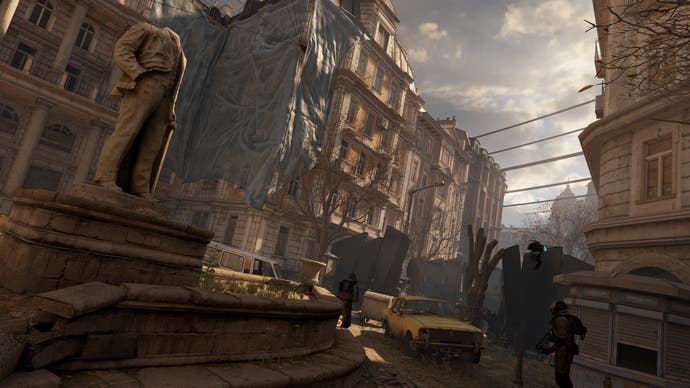
Weapons are real presences because of VR. It's not just that you have to change clips and pull that slidey thing at the top of the pistol before you can shoot the zombie that's already groaning towards you. It's that they have a complex, weighty, rattly presence in your hand. You can sense these guns are each one thing made from many smaller things working together. Valve has always been good with this stuff, and the upgradable weapons of Alyx are very special. From that pistol and a shotgun to something a little more exotic, they're filled with character and a sense of power, even before you start adding laser sites and bigger clips.
Gun management as well as gunplay, wiring puzzles as well as hacking challenges, traversal with physics hurdles so nicely weighted that you can predict the outcomes in your head: all of the various aspects of Alyx appear simple, but they all work together to bed you deeper and deeper into the game until you reach the point where, if you're like me, you're talking back to Russell out loud as you catch up after each fight.
Oh man, but never forget: at the very center of it is all is those incredible gloves. The gravity gun has always had a habit of working its ways into other games for me. Not directly, of course. It's just that I'll be playing Gears of War and I'll see a grand piano or a panel truck and think: I wish I could just lob that somewhere. The gravity gloves have already gone beyond that. They have a habit of getting into my head. I'll be lying on the sofa and thinking: I wish I could just flick that book from the other side of the room into my hand. At the front door I'll wish I could turn around and grab my keys from the stairs. The things I could do with Jaffa Cakes, mate.
The gloves are a less ostentatious kind of magic than that offered in Half-Life 2 - again, you won't be chucking a car at anyone with them - but in some ways they're a more startling kind of magic. I was half an hour in and pausing mid-reload to pull an interesting bit of set design off a distant shelf and inspect it. The levels are filled with bits and pieces to pick up and examine: cutlery, pipes, video cassettes. Chuck in the reloading and this is stuff you can get good at - you can master it until you're fighting through the apocalypse and foppishly checking out the detailing at the same time. Half-Life has always sought to startle, which is probably why the last instalment came out in 2007. The right material, the right opportunities, take time to present itself.
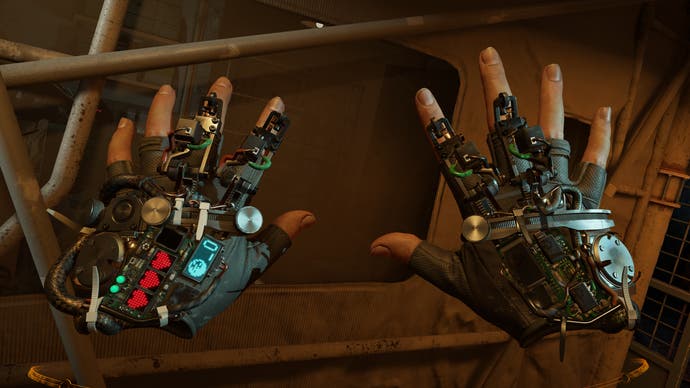
What detailing that lost decade or so has allowed for! This is a game that has been allowed to percolate. City 17, strangely noble in its ravaged state, a faded relic being steadily eaten by alien technology, is still one of the great locations in video games, even if you tend to just see bombed out apartment buildings, train yards and subway stations for a lot of the campaign. But the greatest details this time around are the Combine tech, which has never been so monolithically grim. Outside it's grey sheeting and stark angles: designs that could give you a nasty cut. Inside, though, it's often big chunks of offal instead of circuitry, as if Darth Vader had teamed up with Fergus Henderson, the man behind the nose-to-tail eating movement. Health stations, pretty much unchanged from the first game, are so much more visibly present in VR. You inspect the squealing white worm that is squished to make the lurid Mountain Dew healing substances, and then you have to pull down a plate and rest your hand on it, enjoying the dancing jabs of a dozen little syringes while you scan the surroundings for oncoming threats.
All of this stuff comes together with wonderful set-pieces. Due to the exhausting nature of VR combat, massive pile-ons like Nova Propsekt are out of the question, ditto the open-world ram-raiding of the White Forest. Instead, troops are dropped in surgically - their strangled tannoy barking giving you a moment to panic and hunt for ammo and hopefully come up with a plan. As for the bestiary there's a shocking new enemy who I won't spoil, but even the old guard return and bring a vivid kind of enhanced fear with them. I had dreaded VR headcrabs, and then the game not only introduces them but immediately loses the first one in some pipework. That was a nice two minutes. (I regret to inform you that there's a new kind of headcrab now too, even if its design can't quite match the queasy supermarket horror of the original.) Elsewhere it feels like a testament to the brilliance of the original creature design on this series that you feel dread rather than nostalgia whenever one of the classics turns up again. Or maybe it's another sign of the sheer weight of immersion Alyx can conjure: there's a real sense of apprehension when the game leads you out of the light and back underground for a spell. You live in these spaces while you move through them.
There are ingenious set-pieces, increasingly piling up towards the end of the campaign, but I'm so struck through by the sheer thrift of a lot of it. It's that restraint again: make the VR work, get a handful of killer things out of it, and then repeat and remix without breaking the spell. There are Hollywood moments that will stick with me, but I also remember being in a room filled with oil drums while a tank of explosive gas was being winched up towards the mouth of one of those horrible limpet things that sit on the ceiling. That's the kind of clock Valve likes to put in a scene to add suspense. Hitchcock would be proud: you can see all the moving parts and yet the magic is still there.
And the more I played of Alyx, the more I thought about how VR and Half-Life were made for each other. And the more this left me thinking about the G-Man, the shadowy figure in a suit who turns up at crucial moments throughout the series and does intriguing stuff. The G-Man is the focal point for a lot of lore conspiracies in Half-Life. Who is he? Is he human? Is he Gordon Freeman himself?
Let's not worry whether he makes an appearance in Alyx or not. Maybe it doesn't matter. Because throughout the course of this game, I think I worked out who he really is. He's Valve. Think about it: inscrutable Valve, a company that seems to see further than most, that seems to have a separate agenda to that of most developers - and who, granted, doesn't always seem to be entirely benevolent. The G-Man disappears for long periods of time, but then turns up just as events have caught up with his intentions. It's his way or no way at all. He waits for the right pieces to appear, and then he makes the most of them with little apparent effort.
